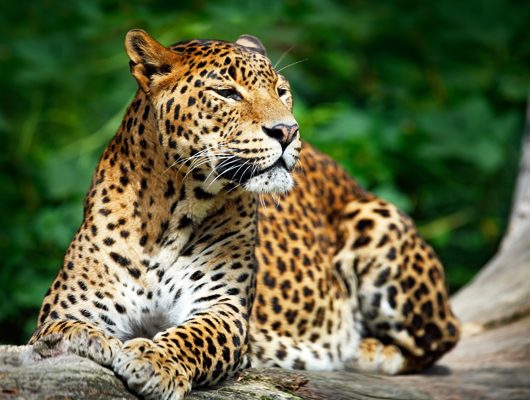The Slender Loris
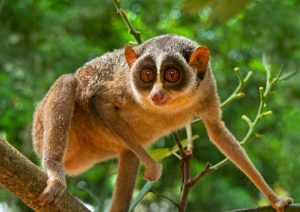 The slender lorises (Loris) are a genus of loris native to India and Sri Lanka. The genus comprises two species, the red slender loris found in Sri Lanka and the gray slender Loris from Sri Lanka and India. Slender lorises spend most of their life in trees, traveling along the tops of branches with slow and precise movements. They are found in tropical rainforests, scrub forests, semi-deciduous forests, and swamps. The primates have lifespans of approximately 15 years and are nocturnal. Slender lorises generally feed on insects, reptiles, plant shoots, and fruit.
The slender lorises (Loris) are a genus of loris native to India and Sri Lanka. The genus comprises two species, the red slender loris found in Sri Lanka and the gray slender Loris from Sri Lanka and India. Slender lorises spend most of their life in trees, traveling along the tops of branches with slow and precise movements. They are found in tropical rainforests, scrub forests, semi-deciduous forests, and swamps. The primates have lifespans of approximately 15 years and are nocturnal. Slender lorises generally feed on insects, reptiles, plant shoots, and fruit.
The red slender Loris is found in Sri Lanka while the gray slender loris is found in Sri Lanka and India. The two subspecies of red slender loris differ in their habitat preference, the lowland loris, L. t. tardigradus, favors wet lowland forests (up to 470 m above sea level) south western wet-zone of Sri Lanka while the mountain loris, L. t. nycticeboides, prefers cloud, montane, and highland evergreen forests at elevations of 1800–2300 m. The gray slender loris can be found in tropical rainforests, primary and some secondary, coastal acacia scrub forests, semi-evergreen forests, swamps, and bamboo groves up to 2000 m above sea level.
Purple Faced Langur
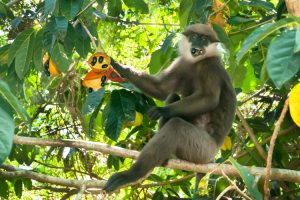 The purple-faced langur (Semnopithecus vetulus), also known as the purple-faced leaf monkey, is a species of Old World monkey that is endemic to Sri Lanka. The animal is a long-tailed arboreal species, identified by a mostly brown appearance, dark face (with paler lower face) and a very shy nature. It is now listed among the 25 globally threatened primates in the world.at present there are four sub species of purple faced langurs in different parts of the Island.
The purple-faced langur (Semnopithecus vetulus), also known as the purple-faced leaf monkey, is a species of Old World monkey that is endemic to Sri Lanka. The animal is a long-tailed arboreal species, identified by a mostly brown appearance, dark face (with paler lower face) and a very shy nature. It is now listed among the 25 globally threatened primates in the world.at present there are four sub species of purple faced langurs in different parts of the Island.
In the purple-faced langur, males are usually larger than females. Males measure 50 to 67.1 cm (19.7 to 26.4 in) in head-body length with a tail of 67 to 85.1 cm (26.4 to 33.5 in). Females possess a head-body length 44.7 to 60 cm (17.6 to 23.6 in) and tail length of 58.9 to 82 cm (23.2 to 32.3 in).
The pelage may generally vary from blackish to grayish. The species tends to have whitish to gray short ‘trousers’ rounded off by purplish-black faces with white sideburns. Part of the back is covered with whitish fur, and tail is also furred with black and white mixed colors. The feet and hands are also purplish-black in color. Size varies among the subspecies. Typically adults will weigh somewhere between 3.1 and 11.4 kg, averaging about 7.08 kg.
The purple-faced langur is mostly folivorous, but will also feed on fruits, flowers, and seeds. While they normally avoid human habitations, fruit such as jak (Artocarpus heterophyllus), rambutan (Nephelium lappaceum), banana (Musa balbisiana), and mango (Mangifera indica) may contribute up to 50% to their diet in cultivated areas.
Loud calls are often used to distinguish between individual purple-faced langurs. The elements of a call fall into three categories: harsh barks, whoops, and residuals. Individuals can be differentiated by the number of phrases and residuals within a call. Calls occur more often in the morning mostly stimulated by neighboring groups and territorial battles. More calls occur during sunny periods than cloudy. The fewest calls occur in the evening. Daytime calls usually aid in the defense of home ranges.
Pangolin
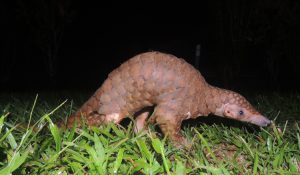 The thick-tailed pangolin, also known as the Indian Pangolin is the bearer of some of the most effective armor of the mammalian world. Its entire body is covered in scales that are moveable and are shed periodically. When threatened the species is able to roll up into a firm ball that protects the unprotected underside of its body, its snout and the inside of its limbs. Unfortunately, the scales that function as their defense against predators, are the main reason these incredible species are so endangered.
The thick-tailed pangolin, also known as the Indian Pangolin is the bearer of some of the most effective armor of the mammalian world. Its entire body is covered in scales that are moveable and are shed periodically. When threatened the species is able to roll up into a firm ball that protects the unprotected underside of its body, its snout and the inside of its limbs. Unfortunately, the scales that function as their defense against predators, are the main reason these incredible species are so endangered.
The pangolin is a distinctive animal that has an elongated shape. It has a cone-shaped head, a mound in the middle (the body), and a thick, tapering tail. Overlapping “armour plates” take the place of fur, but there are some thin, long, light-colored hairs present in the bare parts. Although the body colour of M. crassicaudata is usually yellowish brown, its colour depends on the colour of the earth of its den. The nose of the pangolin has a brown colour. Forelegs are a bit shorter than the hind legs. The sharply curved claws of the front legs, with the third claw being longer than the rest, produce a very unique footprint. The M. crassicaudata is generally solitary, nocturnal and burrow-dwelling except during mating season, when adult males and females share the same burrow.
Pangolins start their food forays after dark, usually around 8 pm. They prey mainly on termites or weaver ants, either on the ground or in trees. Ground nests of termites are torn apart while the tree nests of weaver ants are destroyed to get eggs, young and adults.
These burrows (usually 2-6 m deep) are usually built amongst large rocks, and the entrance is concealed by dirt. Although mainly ground-dwelling, this species is arboreal (live in trees) in some habitats and is a good climber, using its prehensile tail and claws to climb trees. This species is distributed in parts of South Asia that include eastern Pakistan, southern Nepal, Bangladesh, India (south of the Himalayas to extreme southern India) and Sri Lanka. In Sri Lanka, it can be found throughout the lowlands, up to 1100 m in elevation, coinciding with the range of termites.
Fishing Cat
The fishing cat is a wild cat found in South and Southeast Asia. The species is quite fond of water and live in its vicinity, frequently wading in to catch fish, thus the moniker ‘fishing’ cat. The fishing cat is a powerful, short-legged, mid-sized felid with a relatively short and thick tail. Male species are bigger than the female. The body of the fishing cat is olive grey in colour with prominent black stripes that run along the top of the head and neck before changing to spots that appear in a longitudinal direction along the rest of the body extending to the legs. The underside of the body is spotted and white in colour.
They prey primarily on fish, but birds, insects, rodents, mollusks, reptiles and amphibians are also included in their diet in small amounts. However, they are capable of preying on large mammals as well and have been seen scavenging livestock carcasses.
Fishing cats are strongly associated with wetlands. They are typically found in marshlands, mangroves, reed beds, overgrown tanks, streams and riverbanks. They can even be found in paddy fields where there are remnant forest patches nearby to provide refuge. Occasionally, these animals can be seen in suburban environments where they have access to shelter and food sources. Fishing cats are good swimmers and can cover long distances underwater.
Wetland destruction is the primary threat facing this species. Indiscriminate trapping, snaring, poisoning and road accidents are also taking a toll on the dwindling population.
Red Faced Malkoha
The Red-faced Malkoha (Phaenicophaeus pyrrhocephalus) belongs to the family Cuculidae which includes all the species of cuckoos and their allies. This family is noteworthy for their slender hawk like appearance, parasitic behavior and monotonously repeated calls.
There are three species of Malkoha’s in Sri Lanka: the Blue faced Malkoha, the Sirkeer Malkoha and the Red-faced Malkoha. The Red-faced Malkoha is endemic to Sri Lanka; however, there are anecdotal reports of this species occurring in the Western Ghats. This is yet to be justified with solid evidence.
Adult Red-faced Malkohas are black above, glossed with metallic green and blue. The feathers of the crown, nape and chin are flecked with white, the extent of which is subject to marked individual variation. The throat and breast are also black, but the rest of the under-parts are white. When viewed from underneath, as this species usually is, it appears strikingly black and white. The tail is long and graduated and (underneath) appears black at the base and distally white.
The crimson-red face is not bare, but composed of short, bristly hair-like feathers, and in many birds, this protrudes above the crown. The large, laterally compressed bill is apple-green, the lower mandible slightly paler, and is dusky towards the base and around the nostrils. Bold patterning coupled with long tail, red face and green bill makes this species distinctive and extra-ordinarily beautiful.
Most cuckoos are insect-eaters, and whilst the Red-faced Malkoha will snatch insects from the leaves of the canopy, a majority of its diet consists of fruit, especially berries. They move about in the canopy in small groups and form alliances with other species of birds when feeding (mixed species feeding flocks).
The Red-faced Malkoha is a canopy species and prefers the tops of tall trees in thick, undisturbed forest. It occasionally glides to the forest floor, but only in areas of particularly dense undergrowth.
The main threat to its survival is extensive deforestation and habitat fragmentation, particularly in the wet zone, through logging, fuel wood collection, and the growing demand for land for agriculture purposes, gem mining, expanding human habitats and fire. As a primarily canopy-dwelling species, its survival has been particularly badly affected by the degradation of Protected Areas in Sri Lanka.
Sri Lanka Grey Horn bill
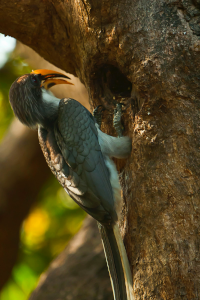 The Sri Lanka Grey Hornbill (Ocyceros gingalensis) was first described in 1811 by Shaw. It is a member of the family Bucerotidae (Hornbills). Hornbills are a family of tropical near-passerine birds found in the Old World.
The Sri Lanka Grey Hornbill (Ocyceros gingalensis) was first described in 1811 by Shaw. It is a member of the family Bucerotidae (Hornbills). Hornbills are a family of tropical near-passerine birds found in the Old World.
Sri Lanka has two species of Hornbills, the Grey Hornbill which is endemic to the island and the Malabar Pied Hornbill (Anthracoceros coronatus) which is also found in other parts of South Asia. The Grey hornbill can be easily set apart from its counterpart (Malabar Pied Hornbill) by lacking the casque (the projection on top of the bill).
Hornbills have rather intriguing way of raising a brood; the female lays around 4 eggs in a tree hole. Once the egg are laid, the male blocks off the entrance to the hole, trapping the female inside, with a mixture of mud, droppings and fruit pulp.
The male leaves a narrow opening, just wide enough to transfer food to the mother and chicks. During the incubation period the female drops (moults) all her feathers. And once the chicks are ready to leave the hollow the female and male break open the hollow, helping the female and chicks to come out. The feathers of the female grow back at the end of this period.
The Grey Hornbill is a large bird about 59 cm in length. Its wings are grey with black primary flight feathers. It has a grey back, and a brown crown. Its long tail is blackish with white sides, and the under part is white. The long curved bill has no casque. The sexes are very much alike; however the male has a cream – coloured bill, whereas in the females, the bill is black with a cream stripe toward the apical of the bill.
The grey hornbill mostly feed on fruits and figs, but is known to feed on small rodents, birds, reptiles and insects, particularly when raising a brood. The species is quite gregarious and is often found in pairs or in small flocks that contain upto 5 individuals (2 adults and 2 to 3 juveniles).
It has an island wide distribution, in forested areas in the wet zone and riverine forest patches in the dry zone. The grey hornbill is frequently found in home gardens, bordering forested areas.
Sri Lankan Jungle fowl
The Sri Lankan Jungle fowl (Gallus lafeyetii) was first described in 1831 by Lesson and is a member of the family Gallus, the same family as the domestic chicken. The ancestor to all domestic chickens is the Red Jungle fowl (Gallus gallus). It has the distinct honor of being the national bird of Sri Lanka and is depicted in postage stamps etc. There are 4 species of Gallus so far recorded from Asia. The Red jungle fowl (Gallus gallus), the Grey jungle fowl (Gallus sonneratii), the green jungle fowl (Gallus varius) and the Sri Lankan jungle fowl (Gallus lafeyetii). The Sri Lanka Jungle fowl is endemic to Sri Lanka, and is not found anywhere else in the world.
As the norm for the genus Gallus, the males and females can be easily identified due to their different colours. Males are reddish orange to yellow in colour, sporting a red comb (crest) and a yellow patch in the centre. Their tail is metallic blue-black. The females are usually different shades of brown in colour with black markings and buff bands on top. They have reddish-brown and black wavy lines, streaked with brownish-buff below, and the rest being largely black-streaked.
The Jungle fowl is a terrestrial species, and is found always scratching the ground for food as with the domestic chicken. They are omnivorous by habit and feed on a myriad of food, ranging from worms, fruits, frogs, and other vertebrates and invertebrates.
The female lays 2 to 4 eggs on nests abandoned by other birds or even squirrels, or on nests built on the forest floor of Sri Lanka’s hill country. Males play an active role in protecting the nests an in rearing chicks.
The call of the Jungle fowl is said to sound like the name John Joyce, which is repeated every few seconds. They are also known to flap their wings, this sound is made when a male announces his arrival or when there is a territorial dispute amongst males.
This species has a wide distribution range covering all climatic zones, from the low country to the highest peaks found on Sri Lanka. It is commonly found in forest and scrub habitats.
The Sri Lanka Blue Magpie
The Sri Lanka Blue Magpie (Urocissa ornate) was first described in 1829 by Wagler and is a member of the crow family – the Corvidae. Crows, ravens, rooks, jackdaws, jays, magpies, treepies, choughs and nutcrackers all belong to this family. Birds in the family Corvidae are considered the most intelligent birds in the world. The family Urocissa consists of five species, distributed throughout Asia, with the Sri Lankan blue magpie being endemic to Sri Lanka. This family (Urocissa) consists of some of the most brightly coloured birds in the world, and definitely the most brightly coloured in the family Corvidae.
The blue magpie is found in small groups of 3-7 birds. Their nest, usually situated on a tree or shrub, is made of sticks and is somewhat similar to the crow’s nest. They lay between 3-5 eggs, which are white with brown mottling.
It is found in the wet zone and upper montane regions of the island; however they are not found from the highest peaks.
It is an omnivorous bird and will feed on any sort of food matter; however it prefers to eat frogs, lizards, insects and other invertebrates.
The Sri Lankan Blue magpie population is dwindling, due to loss of habitat caused by extensive clearance and degradation of forests. The Sri Lankan Blue Magpie is legally protected in Sri Lanka
The spot-winged thrush
The spot-winged thrush, (Geokichla spiloptera), is an Asian thrush, a group within the large thrush family Turdidae. It is an endemic resident breeder in Sri Lanka. This uncommon species breeds in hill rainforests, and to a lesser extent in drier woodlands, at altitudes between 500 and 2000 m. The wintering areas are similar but include less well-wooded areas, and are generally at 750 to 1500 m altitude. The spot-winged thrush is generally solitary and can be quite secretive, especially in the dense undergrowth and bamboo clumps it favours. Spot-winged thrushes are omnivorous, but eat far more insects than fruit. They feed on the ground.

